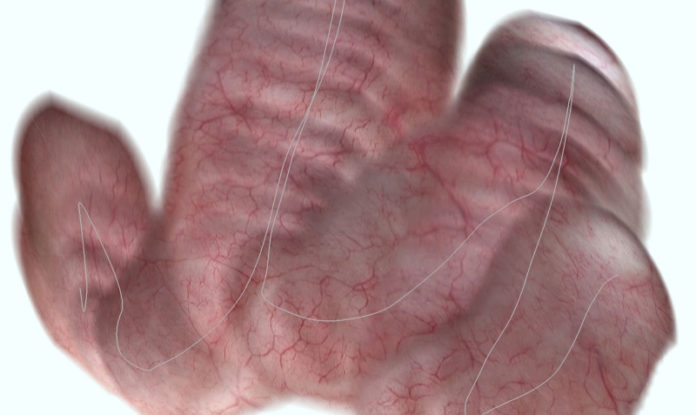
Whether physicians examine or operate on the bladder wall with an endoscope, they can catch a glimpse of only a miniscule section of the organ — their viewpoint is like that of someone looking through a keyhole. But soon, however, this perspective could be broadened to a panorama. ‘Endorama’, a new software program, assembles this panorama from all the images acquired. Researchers from Fraunhofer IIS will present their research project at MEDICA, the medical device technology fair in Düsseldorf, from November 12th to 15th, 2014.
If it hurts to pass water, or if there is blood in one’s urine, this could be a sign of bladder cancer. An endoscopic examination will help clarify the situation: The physician inserts a rigid or flexible endoscope with an attached camera into the patient’s bladder, and examines the tissues for potentially unusual changes. While such minimally invasive studies can run quite painlessly for the patient, they relate to certain challenges for the examiner. For example, he can only see the tiny section of the organ wall that the camera has just captured. If the physician needs more image data about the environment, then he has to move the camera and mentally compile the information seen. It is additionally difficult for him to assess if he has successfully examined all areas of the bladder wall.
“The ‘Endorama’ software program that we engineered fuses all recorded images together into a large panorama image — and does so almost in real time,” explains PD Dr. Thomas Wittenberg, group manager and senior scientist at the Fraunhofer Institute for Integrated Circuits IIS in Erlangen. In the future, the physician might be able to look at the entire area of the bladder at a single glance. The software takes the image that the camera currently records and in each case displays it at the center of the screen. If the computer panorama displays a “hole” at some point, then the physician knows that he has not yet examined the bladder wall at that point. ‘Endorama’ also provides advantages even when it comes to documentation and records: Instead of a single image or a video file, the physician can stitch together the panoramic image into the patient files, because this image depicts the entire investigative findings and additionally documents that the bladder was studied seamlessly.
25 images per second
In order to prepare a panorama like this, the camera on the endoscope acquires about 25 pictures a second, which overlap each other. The software searches for distinctive features in the images and based on these structures, compiles them into a complete overall picture. Whereas panoramic images are common in conventional photography, and can be taken with the right app on a smart phone, for example, they also harbor a number of challenges when it comes to endoscopy imaging: Optically, these images as a rule are sharply distorted, feature low resolution and even the image contrast is relatively minimal due to the irregular lighting. In addition, the structures in the bladder are weakly expressed; therefore, it is important to find distinctive points, on the basis of which the overlapping images can be compiled. ‘Endorama’ makes all this possible: In a first step, the software corrects the optical distortions and balances out the shadows that arise due to the non-homogenous lighting. Various computer processes assemble the images: while one process searches for designated image features, such as vascular structures on the bladder wall, another is fitting the images together in an organized manner. In doing so, these processes also take into account the complex geometry of the bladder.
‘Endorama’ has already passed initial tests successfully: The researchers reviewed the software initially using a phantom configuration; a ten-centimeter plastic ball on whose inner side the vascular structure of the bladder was mapped. The scientists also assembled video sequences which were obtained from standard bladder examinations into panoramas. Based on Wittenberg’s estimates, ‘Endorama’ could be available on the market in about two to three years. Also versions for the sinus cavities, the abdominal cavity, the intestines and the larynx are possible.
Story Source:
The above story is based on materials provided by Fraunhofer-Gesellschaft. Note: Materials may be edited for content and length.
